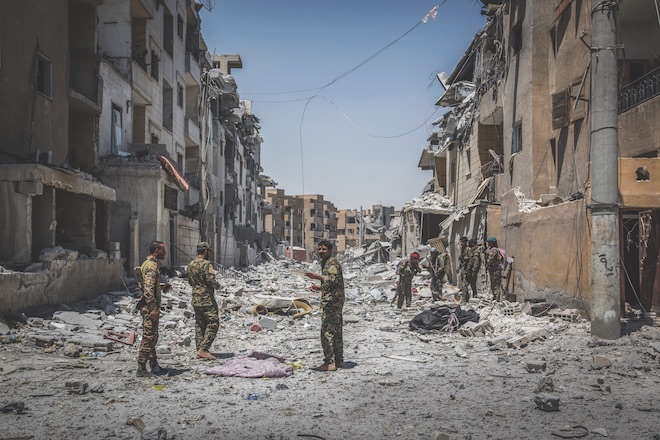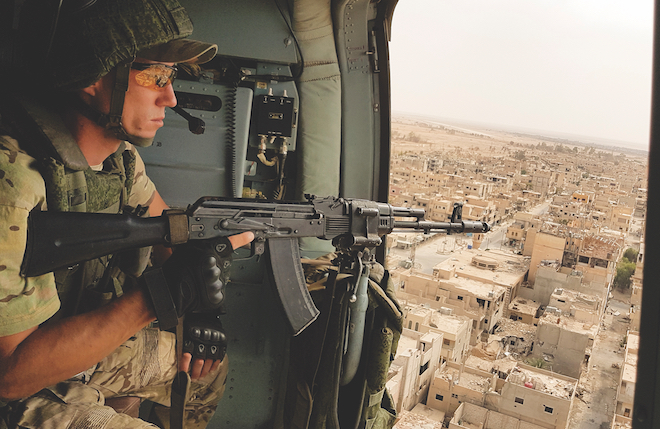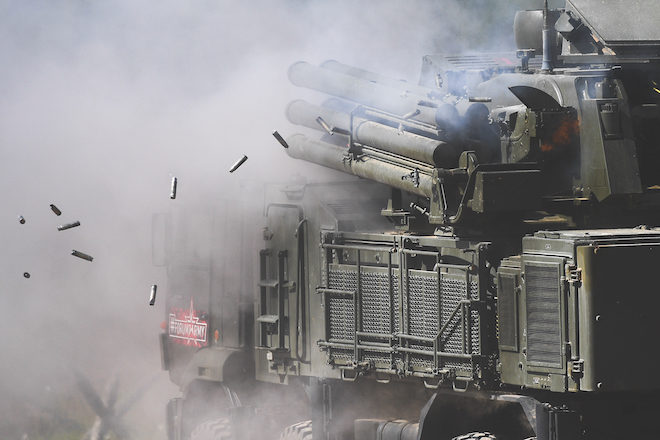
The United States must refocus its military objectives in Syria or risk ceding influence to Russia.
The United States is engaged in a renewed great power competition with Russia, a country that maintains an impressive assortment of nuclear weapons and antiaccess military tools. What makes the Kremlin’s behavior so alarming, however, is not the lethality and reach of its weaponry, but its disaffection with the U.S.-led international order that has organized global affairs for the past 70 years. This dynamic is front and center in the Syria conflict, where Russia’s strategic intent is concerning.
Managing great power competition requires a clear-eyed assessment of Russian operations in Syria—Moscow’s only current out-of-area military contingency. Events on the ground in 2018 have marked a turning point in the Syrian conflict to one more concerned with regional influence and national interests than the ultimate defeat of the Islamic State. Given these dynamics, and Russia’s effort to expand its sphere of influence, U.S. military objectives and forward presence should be revised for the competition in which the United States is engaged. The current strategy and force level in theater are inadequate, and a premature withdrawal from the region not only risks campaign objectives against the Islamic State, but also cedes key territory, maneuver space, and influence opportunities to Russia and Iran.
Shift in the Syrian Civil War
The situation on the ground in Syria and the role of external actors have changed measurably in 2018. What started as a grassroots protest against Syrian President Bashar al-Assad in the early days of the Arab Spring has transitioned to a regional struggle to gain control and influence in Syria.1 Tactical aircraft from six different countries, a broad assortment of proxy fighters, and ground forces from the United States, Russia, Turkey, and Iran all are working to gain an advantage. During a one-week period in February 2018, Russia, Iran, and Israel all had combat aircraft destroyed by enemy fire.
Independent groups estimate that the Syrian government controls half the country, including most of the largest cities, with strong backing from Russia and Iran.2 Next, the United States has great influence over an estimated 27 percent of the country that was taken from the Islamic State by the combination of Syrian Democratic Forces (SDF) and U.S. airpower and special operations forces (SOF).3 The SDF is comprised mostly of Kurdish People’s Protection Unit (YPG) fighters and some Syrian Arabs, and the territory largely is on the eastern side of the Euphrates River. Turkey also holds sections of ground in northern Syria, and it launched an offensive into the Kurdish enclave of Afrin in northwest Syria at the end of January 2018 (reportedly with Russia’s endorsement).4 Kurdish fighters in Afrin have not received U.S. assistance during the conflict, but Turkey’s Afrin offensive drew Kurdish resources away from the counter-Islamic State mission in eastern Syria.

(Associated Press)
Russia holds significant influence in Syria, as its intervention—beginning in 2015—has enabled the Assad regime to retake most of the territory it lost during the initial years of the conflict. Russia has contributed ground advisors, contract soldiers, airpower, and power projection with stand-off missiles. Its involvement has not led to the quagmire some predicted, but there have been costs.5 While flying a combat air patrol over Idlib province on 3 February 2018, a Russian Su-25 Frogfoot was shot down by a shoulder-fired missile. While al Qaeda claimed responsibility for the shootdown, Moscow blamed the United States.
Three events occurred in early 2018 that frame the current nature of the conflict. On 7 February, Syrian government forces, including Russian contract soldiers, advanced on a known SDF position in Deir al-Zour province, key terrain between the Euphrates River Valley and the Iraq border but well within the U.S.-controlled deconfliction zone. This offensive, which marked the most dangerous confrontation between the United States and pro-government ground forces since the United States intervened in 2014, was met with a considerable U.S.-led response that resulted in the deaths of scores of pro-government forces (including Russian contract soldiers).6
Three days later, Israel intercepted and shot down an Iranian unmanned aerial vehicle (UAV) that had penetrated Israeli airspace, but it lost an F-16 to Syrian surface-to-air fire during the ensuing Israeli counterstrike into Syrian territory. Finally, on 14 April, the United States, United Kingdom, and France launched stand-off strikes at three Syrian targets associated with the Syrian chemical weapons program in retaliation for Assad’s use of chemical weapons in Douma, Syria, on 7 April.
Russia’s interests in Syria are long-standing. The difference now is that Russia has made Syria a key location from which it can overtly compete with the United States for influence in the Middle East. Russia not only has demonstrated it is capable of assembling a rival expeditionary coalition in opposition to the United States, but it also has managed the diplomatic coup of convincing an established U.S. ally—Turkey—to support the Astana process and some of Moscow’s plans to stabilize Syria.7 As part of its larger effort to weaken the international order, Russia established the Astana process as a competing effort to the United Nations-led and U.S.-supported Geneva process for resolving the Syrian civil war. Many of the actors involved in the Syrian conflict now view the Astana process as the primary diplomatic venue for ending the war, and Russia has resisted pressuring Assad to support the Geneva initiative.
Russia clearly is seeking to assemble a new power axis with Iran and Turkey centered in Syria. These countries have met multiple times at the head-of-state level, including as recently as 7 September in Tehran, to discuss Syria’s future. There has never been a representative from the United States at these meetings, and the sessions tend to reinforce the narrative that Russia is the ultimate decider of Syria’s fate. Shortly after the November 2017 Sochi meeting, Turkey announced it was purchasing a Russian S-400 surface-to-air missile system. In anticipation of the July Helsinki summit, several Middle Eastern leaders, including Israeli Prime Minister Benjamin Netanyahu, reached out to Russia or made trips to Moscow to address the future of Syria.
Military Implications
Russia’s renewed effort to play a dominant role in Syria has forced the United States to refocus its objectives. In addition to fully eliminating the Islamic State and setting the conditions to prevent its regeneration, the United States needs to deter Russia and counter Iran’s malign behavior to ensure the regional balance of power is favorable to U.S. interests.
Vladimir Putin has announced that Russia is leaving Syria, but its military has not because the Russian president recognizes the stakes. An expeditionary operation on Russia’s periphery in support of a critical ally is central to Moscow’s narrative of its return to global power status. In Syria, Russia plays the role of both “arsonist and firefighter.”8 According to General Joseph Votel, Commander, U.S. Central Command, Russia is adept at “fueling tensions and then trying to resolve them in their favor, and then manipulating all the parties they can in order to achieve their objectives.”9 In this way, Russia adroitly combines its diplomatic, military, and information sources of national power.
With a naval base in Tartus and an air base on the outskirts of Latakia, Syria provides Russia with a geographic location from which it can influence regional states (most notably Egypt, Libya, and Turkey) and challenge NATO’s southern flank. These bases also are Moscow’s only overseas military stations. Russia maintains a variety of advanced weapons in Syria, including long-range antiship cruise missiles, high-end surface-to-air missile systems, and tactical aircraft designed to achieve air superiority. It sustains an assortment of upgraded surface ships and submarines deployed to the eastern Mediterranean Sea, most notably improved Kilo-class submarines and Admiral Grigorovich-class frigates, which fired Kalibr missiles into Syria in June 2017 (units are homeported in Russia’s Black Sea Fleet in Sevastopol, Russia, but use Tartus for maintenance and logistics support). According to Admiral James Foggo, Commander, Allied Joint Force Command Naples and U.S. Naval Forces Europe and Africa, Russia is using the eastern Mediterranean as a base of operations.10 In addition, news reports from April discussed Russia’s jamming of U.S. surveillance aircraft in Syria.11

Russia has a variety of advanced weapons in Syria, including the Pantsir S1 missile system being used by Syrian government forces. (Sputnik)
Collectively, these high-end capabilities allow Russia to project power well beyond Syria’s borders and demonstrate that Russia is competing with the United States and NATO alliance and not simply fighting terrorists. They also show how Russia’s presence complicates U.S. regional basing, access, and maneuver space. As General Votel has noted, Syria is Russia’s testing ground for military capabilities.12
One of the major contributors to U.S. success during the Cold War was its robust military alliance structure. The current National Defense Strategy doubles down on this point and underscores “strengthening alliances and attracting new partners” as one of three lines of effort in managing the long-term strategic competition. Russian operations in Syria have driven a wedge between the United States and a critical NATO ally (Turkey), prevented the United States from maximizing the ground combat capability of the SDF, and curbed what is typically an asymmetric strategic advantage for the United States.
U.S. Forward Presence
Great power competition requires a commitment to maintaining a combat-credible forward presence to deter and win the strategic contest in areas of geopolitical importance. This goal should be seen as complementary to the effort to eliminate the Islamic State, prevent extremist regeneration, and impede Iran’s malign influence in the Middle East. The U.S. joint force has a number of capabilities that could support this effort.
First, increase U.S. naval assets in the eastern Mediterranean Sea, including a regular carrier strike group (CSG) presence. The positioning earlier this year of the Harry S. Truman CSG gave the joint force an expanded, highly mobile strike capability and an additional level of deterrence that should be sustained. Along with a CSG, additional cruisers and destroyers also would enhance deterrence and power projection from the maritime domain and demonstrate that the U.S. Navy is prepared to disrupt and defeat Russian naval capabilities in the eastern Mediterranean.
Second, increase key intelligence, surveillance, and reconnaissance assets and enablers to operate at a faster, search-to-kill cycle than competitors in the region, including state and nonstate actors.
Finally, expand the U.S. ground advisor presence to sufficiently enable the SDF to secure Syria east of the Euphrates and to work with its Turkish partners to stabilize the Turkey-Syrian border (primarily northwest Syria). This requires walking a military-diplomatic tightrope, but it is necessary to prevent Russia and Iran from controlling Syria’s future and cementing their influence in the region.
Working with allies and partners, the U.S. joint force has played a substantial role in a series of notable accomplishments in the past two years in the fight against the Islamic State, including supporting the liberation of Mosul, Iraq, and seizure of Raqqa, Syria. A premature withdrawal from the region, however, places these gains at risk and misses the larger issue of the role played by Syria in the U.S. long-term strategic competition with a resurgent Russia.
Since 2001, the United States has experienced difficulty connecting military tactical and operational success with lasting strategic gains. Without reframing military objectives for great power competition given the situation on the ground, the United States risks allowing Syria to become the latest Icarus—swept to tactical victory, only to be singed in strategic defeat.
1. Liz Sly and Loveday Morris, “Syria’s War Mutates into Regional Conflict,” Washington Post, 13 February 2018.
2. Sly and Morris, “Syria’s War Mutates into Regional Conflict.”
3. Sly and Morris, “Syria’s War Mutates into Regional Conflict.”
4. Leonid Issaev, “Why Is Russia Helping Turkey in Afrin,” Al Jazeera, 29 January 2018.
5. Michael Crowley, “Putin Bogging Down in Syria,” Politico, 10 December 2015.
6. Liz Sly, “U.S. Troops in Syria May Be At Risk of ‘Mission Creep’ After Deadly Battle,” Washington Post, 9 February 2018.
7. Michael Kofman, “Searching for Strategy in Washington’s Competition with Russia,” War on the Rocks, 30 January 2018,.
8. Missy Ryan, “After ISIS, U.S. Military Confronts Challenge from Russia, China in the Middle East,” Washington Post, 27 February 2018.
9. Kofman, “Searching for Strategy.”
10. Vassilis Nedos, “Souda Bay Is ‘World-Class,’ U.S. Navy Admiral James Foggo Tells Kathimerini,” Ekathimerini.com, 14 May 2018.
11. Courtney Cube, “Russia Has Figured Out How to Jam U.S. Drones in Syria, Officials Say,” NBC News, 10 April 2018.
12. Ryan, “After ISIS.”
Commander Gilmore served as the senior intelligence officer on board the USS George H. W. Bush (CVN-77) for its 2017 Operation Inherent Resolve deployment, and was the 2017–18 Navy Federal Executive Fellow at the RAND Corporation. He currently is assigned to the Joint Staff.


